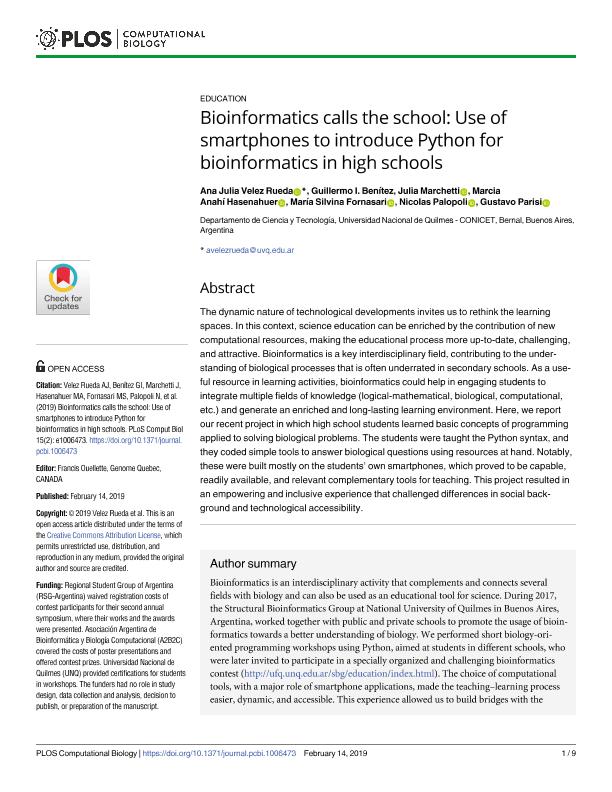Mostrar el registro sencillo del ítem
dc.contributor.author
Velez Rueda, Ana Julia

dc.contributor.author
Benítez, Guillermo Ignacio

dc.contributor.author
Marchetti, Julia

dc.contributor.author
Hasenahuer, Marcia Anahí

dc.contributor.author
Fornasari, Maria Silvina

dc.contributor.author
Palopoli, Nicolás

dc.contributor.author
Parisi, Gustavo Daniel

dc.date.available
2020-11-11T19:15:45Z
dc.date.issued
2019-02
dc.identifier.citation
Velez Rueda, Ana Julia; Benítez, Guillermo Ignacio; Marchetti, Julia; Hasenahuer, Marcia Anahí; Fornasari, Maria Silvina; et al.; Bioinformatics calls the school: Use of smartphones to introduce python for bioinformatics in high schools; Public Library of Science; Plos Computational Biology; 15; 2; 2-2019; 1-09
dc.identifier.issn
1553-734X
dc.identifier.uri
http://hdl.handle.net/11336/118194
dc.description.abstract
The dynamic nature of technological developments invites us to rethink the learning spaces. In this context, science education can be enriched by the contribution of new computational resources, making the educational process more up-to-date, challenging, and attractive. Bioinformatics is a key interdisciplinary field, contributing to the understanding of biological processes that is often underrated in secondary schools. As a useful resource in learning activities, bioinformatics could help in engaging students to integrate multiple fields of knowledge (logical-mathematical, biological, computational, etc.) and generate an enriched and long-lasting learning environment. Here, we report our recent project in which high school students learned basic concepts of programming applied to solving biological problems. The students were taught the Python syntax, and they coded simple tools to answer biological questions using resources at hand. Notably, these were built mostly on the students’ own smartphones, which proved to be capable, readily available, and relevant complementary tools for teaching. This project resulted in an empowering and inclusive experience that challenged differences in social background and technological accessibility.
dc.format
application/pdf
dc.language.iso
eng
dc.publisher
Public Library of Science

dc.rights
info:eu-repo/semantics/openAccess
dc.rights.uri
https://creativecommons.org/licenses/by-nc-sa/2.5/ar/
dc.subject
BIOINFORMATICS
dc.subject
SECONDARY SCHOOL
dc.subject
PYTHON
dc.subject.classification
Ciencias de la Información y Bioinformática

dc.subject.classification
Ciencias de la Computación e Información

dc.subject.classification
CIENCIAS NATURALES Y EXACTAS

dc.subject.classification
Educación General

dc.subject.classification
Ciencias de la Educación

dc.subject.classification
CIENCIAS SOCIALES

dc.title
Bioinformatics calls the school: Use of smartphones to introduce python for bioinformatics in high schools
dc.type
info:eu-repo/semantics/article
dc.type
info:ar-repo/semantics/artículo
dc.type
info:eu-repo/semantics/publishedVersion
dc.date.updated
2020-11-11T12:33:15Z
dc.journal.volume
15
dc.journal.number
2
dc.journal.pagination
1-09
dc.journal.pais
Estados Unidos

dc.journal.ciudad
San Francisco
dc.description.fil
Fil: Velez Rueda, Ana Julia. Universidad Nacional de Quilmes. Departamento de Ciencia y Tecnología; Argentina. Consejo Nacional de Investigaciones Científicas y Técnicas; Argentina
dc.description.fil
Fil: Benítez, Guillermo Ignacio. Universidad Nacional de Quilmes. Departamento de Ciencia y Tecnología; Argentina. Consejo Nacional de Investigaciones Científicas y Técnicas; Argentina
dc.description.fil
Fil: Marchetti, Julia. Universidad Nacional de Quilmes. Departamento de Ciencia y Tecnología; Argentina. Consejo Nacional de Investigaciones Científicas y Técnicas; Argentina
dc.description.fil
Fil: Hasenahuer, Marcia Anahí. Consejo Nacional de Investigaciones Científicas y Técnicas; Argentina. Universidad Nacional de Quilmes. Departamento de Ciencia y Tecnología; Argentina
dc.description.fil
Fil: Fornasari, Maria Silvina. Consejo Nacional de Investigaciones Científicas y Técnicas; Argentina. Universidad Nacional de Quilmes. Departamento de Ciencia y Tecnología; Argentina
dc.description.fil
Fil: Palopoli, Nicolás. Universidad Nacional de Quilmes. Departamento de Ciencia y Tecnología; Argentina. Consejo Nacional de Investigaciones Científicas y Técnicas; Argentina
dc.description.fil
Fil: Parisi, Gustavo Daniel. Universidad Nacional de Quilmes. Departamento de Ciencia y Tecnología; Argentina. Consejo Nacional de Investigaciones Científicas y Técnicas; Argentina
dc.journal.title
Plos Computational Biology

dc.relation.alternativeid
info:eu-repo/semantics/altIdentifier/doi/http://dx.doi.org/10.1371/journal.pcbi.1006473
dc.relation.alternativeid
info:eu-repo/semantics/altIdentifier/url/https://journals.plos.org/ploscompbiol/article?id=10.1371/journal.pcbi.1006473
Archivos asociados
